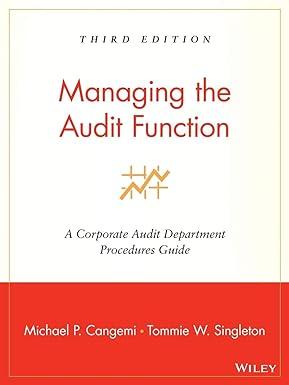Question
37. Cariboo Manufacturing Company incurred a joint cost of $804,000 in the production of X and Y in a joint process. Presently, 2,600 of X
37. Cariboo Manufacturing Company incurred a joint cost of $804,000 in the production of X and Y in a joint process. Presently, 2,600 of X and 2,200 of Y are being produced each month. Management plans to decrease X's production by 700 units in order to increase the production of Y by 980 units. Additionally, this change will require minor modifications, which will add $54,720 to the joint cost. This cost is entirely attributable to product Y. What is the amount of the joint costs allocable to X and Y before changes to existing production, assuming Cariboo allocates their joint costs according to the proportion of Y and X produced?
| Product X | Product Y | |||||
| A. | $ | 368,500 | $ | 435,500 | ||
| B. | $ | 362,706 | $ | 441,924 | ||
| C. | $ | 371,529 | $ | 432,471 | ||
| D. | $ | 435,500 | $ | 368,500 | ||
Option C
Option A
Option B
Option D
38. Altoona Corporation has two divisions, Hinges and Doors, which are both organized as profit centers; the Hinge Division produces and sells hinges to the Door Division and to outside customers. The Hinge Division has total costs of $40, $26 of which are variable. The Hinge Division is operating significantly below capacity and sells the hinges for $55. The Door Division has received an offer from an outsider vendor to supply all the hinges it needs (20,000 hinges) at a cost of $50. The manager of the Door Division is considering the offer but wants to approach the Hinge Division first. What would be the profit impact to Altoona Corporation as a whole if the Door Division purchased the 20,000 hinges it needs from the outside vendor for $50?
No change in profit to Altoona.
$480,000 decrease in profits.
$100,000 increase in profits.
$100,000 decrease in profits.
39. Dockside Enterprises, Inc., operates two divisions: (1) a management division that owns and manages bulk carriers on the Great Lakes and (2) a repair division that operates a dry dock in Tampa, Florida. The repair division works on company ships, as well as other large-hull ships. The repair division has an estimated variable cost of $47 per labor-hour. The repair division has a backlog of work for outside ships. They charge $87 per hour for labor, which is standard for this type of work. The management division complained that it could hire its own repair workers for $57 per hour, including leasing an adequate work area. If the repair division had idle capacity, what is the minimum transfer price that the repair division should obtain?
$47.
$57.
$40.
$87.
Step by Step Solution
There are 3 Steps involved in it
Step: 1

Get Instant Access to Expert-Tailored Solutions
See step-by-step solutions with expert insights and AI powered tools for academic success
Step: 2

Step: 3

Ace Your Homework with AI
Get the answers you need in no time with our AI-driven, step-by-step assistance
Get Started


